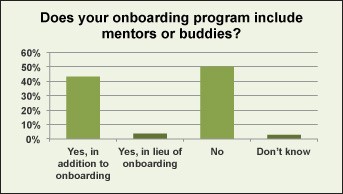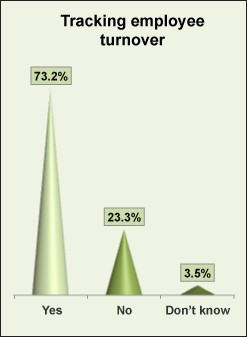In yesterday’s Advisor, we presented results from our 2014 Recruiting and Retention Survey. Today, more findings from this timely study, including practices for new hires and preferred methods of retention.
A total of 919 individuals participated in this survey, conducted in November 2014.
New Hire Programs
Getting new employees on board is formalized for 88.4%. It is an ongoing process during the first 1 to 3 months of employment for 22.3% and involves 1 to 2 hours of orientation for 18.3%. Multiple sessions spread across several days within the first week of employment is the norm for 17.4%, and a single, full day is the process for 10.7%. A half-day is utilized by 16.1%. Benefits enrollment occurs during orientation for 36.2%. It is during the first week of employment for 17% and during the first month for 25.5%.
Management team members participate in the onboarding process for 75.3%. Training on how to successfully onboard new employees is received by 46.8% (up from 38.3% in 2013), and mentors or buddies for new employees are provided by 43.2%.

Retention
Employee turnover is tracked by 73.2%, with management turnover at 1% to 10% for 38.6% and for professionals, it’s the same rate for 37.1%. Turnover of mid-level employees is below 10% for 37.1% and 11% to 25% for 15.6%. The rate of turnover for entry-level employees is under 10% for 25.8% and 11% to 25% for 18.5%.

This survey looked at retention from two different perspectives. First, we asked participants to select the options they use to retain qualified employees from a list of common practices. Here are their top 10 selections:
|
1 |
Adequate benefits |
83.6% |
|
2 |
A safe, healthy work environment |
69.4% |
|
3 |
Fair and equitable treatment |
61.3% |
|
4 |
Training and development opportunities |
60.6% |
|
5 |
Pay at or above market rate |
55.1% |
|
6 |
Employer trust, respect, and consideration |
51.5% |
|
7 |
Opportunity for advancement |
51.2% |
|
8 |
Appropriate and fair discipline for rule breakers |
50.9% |
|
9 |
Engagement between employers and managers |
49.7% |
|
10 |
Incentives such as bonuses and profit-sharing |
49.1% |
Next, we asked survey participants to select, from the same list, which practices are most effective when it comes to retaining employees. Here’s the top 10:
|
1 |
Adequate benefits |
67.6% |
|
2 |
Pay at or above market rate |
65.2% |
|
3 |
Employer trust, respect, and consideration |
65.3% |
|
4 |
Fair and equitable treatment |
63% |
|
5 |
Effective management |
58.6% |
|
6 |
Engagement between employers and managers |
57.9% |
|
7 |
Opportunity for advancement |
57.3% |
|
8 |
Training and development opportunities |
52.2% |
|
9 |
Performance recognition and reward |
50.9% |
|
10 |
Work/life balance through telecommuting, flextime, etc. |
50.1% |
As you can see, many of the selections were the same and, realistically, to be expected. What might not be expected, however, is what’s different. For example, a safe and healthy work environment came in second for methods used but didn’t make the cut for what works to retain employees. Also, the items that came in tenth show that cash incentives are used but providing work/life balance is more effective.
Is your organization prepared to attract and screen the best candidates? Start today with the free webcast download, Creating Talent Pools to Fill Your Pipeline. Learn More
Survey Participants
A total of 919 individuals participated in this survey, which was conducted in November 2014. Of those who identified themselves, 58.5% represent privately owned companies, 21.3% are with nonprofit organizations, 10.7% are with public entities, and 9.5% work for government organizations.

The majority (56.2%) of our survey respondents provide HR services to a workforce of 1 to 250 employees. Another 14.3% provide guidance to 251 to 500 employees at their organizations, and 11.3% have a workforce of 501 to 1,000 employees. Companies with more than 1,000 employees account for 18.3% of survey participants.
A little below 25% of survey respondents (24.1%) have a workforce that is more than 50% exempt employees. As for unions, less than 10% of the employers surveyed have a workforce that is 50% to 100% unionized, and 85.5% have a workforce where less than 25% are union employees.
Over half (65%) of the participants are in service industries; 21% are in agriculture, forestry, construction, manufacturing, or mining; 10% are in wholesale, retail, transportation, or warehousing; and 3% are in real estate or utilities.
Managers account for 54.6% of the survey participants who self-identified, VP or higher make up 23.5%, supervisors are 5.7%, and staff-level employees round out the field of survey participants at 16.1%.
Thanks again to all who participated!
Recruiting and retention will be a top challenge for 2015. Now more than ever, it is imperative that recruiters have access to the tools & techniques that allow them to support a growing company and ensure a continuous pipeline of qualified candidates. How to get there? Fortunately there’s help in the form of a timely webcast—Creating Talent Pools to Fill Your Pipeline. In just a short time, you’ll learn everything you need to know about how the iCIMS Talent Platform can help you win the war for top talent.
Register today for this free (thanks to sponsor iCIMS) webcast.
Win the war for talent. Download the free webcast, Creating Talent Pools to Fill Your Pipeline. Register Now
By participating in this interactive webcast, you’ll learn:
- Tips on Addressing the Skills Gap: Learn best practices for finding highly skilled workers.
- Tools to Recruit Proactively vs. Reactively: Attract a tech savvy workforce for your pipeline.
- Strategies to Enhance Recruitment: Understand the benefits of having a Talent CRM.
Also included is a product walk-through, where you can tour the iCIMS Platform to screen and hire candidates with ease.
